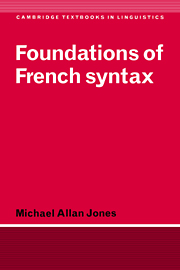2 - Verbs and Verb Phrases
Published online by Cambridge University Press: 14 January 2010
Summary
Overview
The verb can be considered the key element in the sentence in the sense that it provides the link between all the other major constituents of the sentence. Consequently, the form and interpretation of a given sentence depends to a very large extent on the properties of the verbs which it contains.
2.2 begins with a classification of verbs according to semantic notions such as ‘state’, ‘process’, ‘action’, etc. In 2.3 and 2.4 verbs are investigated according to the types of complements they can take, applying the system of lexical representation introduced in 1.2.4 to explore the ways in which theta-roles are expressed in terms of grammatical relations.
The verbs âtre and avoir are atypical in that they do not describe particular types of states or events, but rather provide a syntactic link be ween the subject and the complement which together express the basic semantic content of the sentence. The properties of these verbs are discussed in 2.5–2.6 along with other complement constructions which express relations of a similar type without recourse to a verb.
Auxiliary verbs have a rather similar status, supplementing the information conveyed by the main verb. In 2.7 we concentrate on the syntactic properties of verbs which are traditionally classified as auxiliaries (their semantic contribution, particularly as it relates to the concept of time, is analysed m chapter 4). In 2.8 we consider the related questions of the choice of auxiliary (avoir vs etre) in compound tenses and agreement of the past-participle.
- Type
- Chapter
- Information
- Foundations of French Syntax , pp. 50 - 98Publisher: Cambridge University PressPrint publication year: 1996

